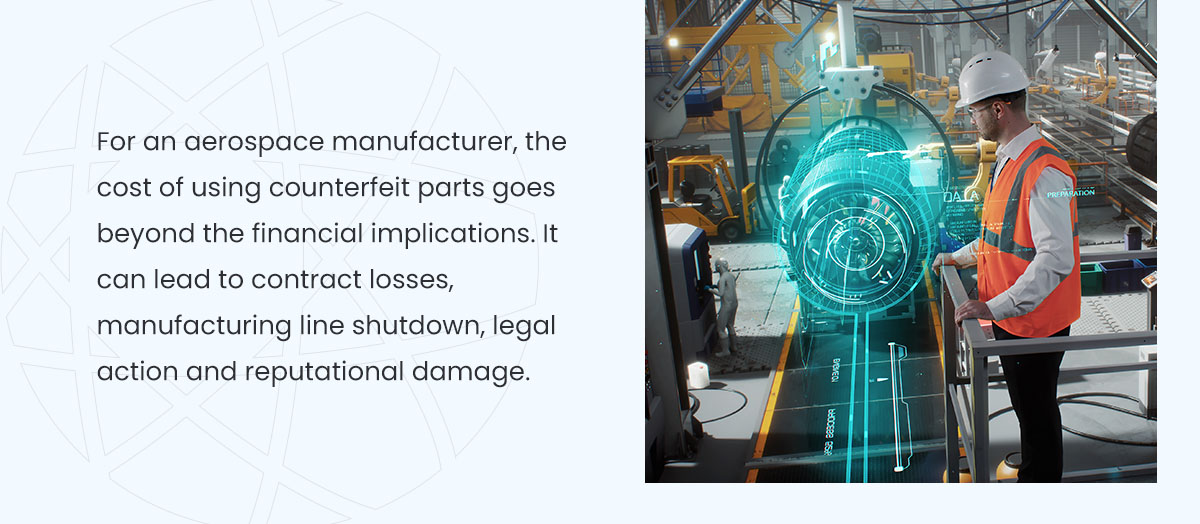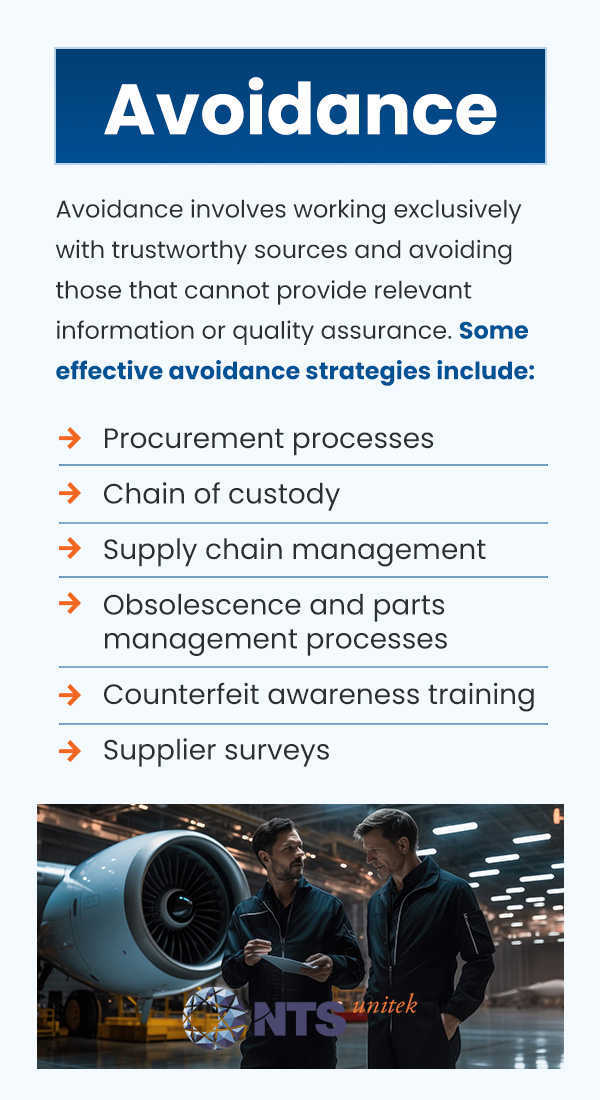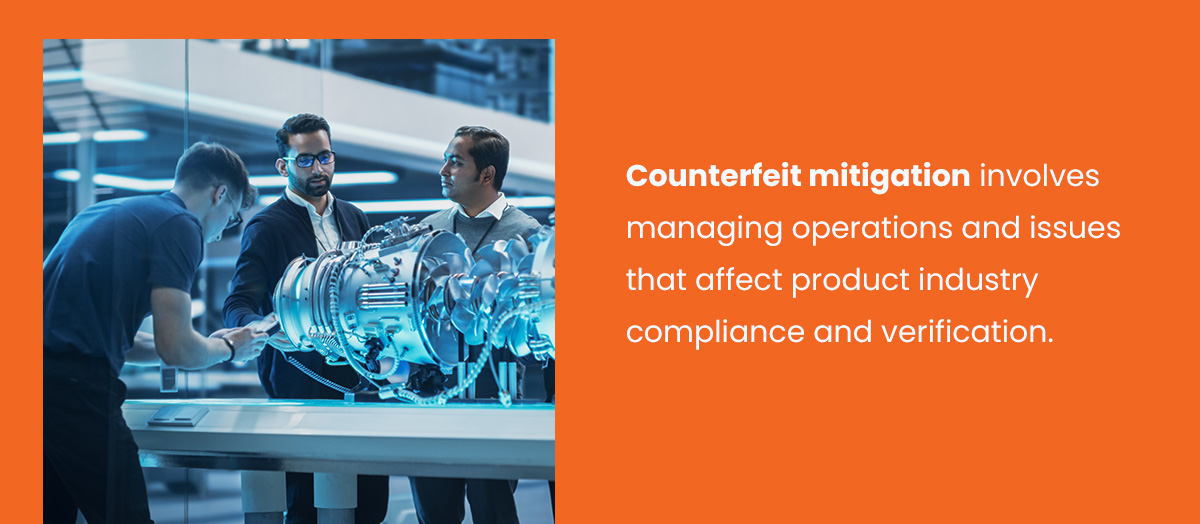In recent years, counterfeiting products has become a more common practice, affecting a significant number of industries and creating severe consequences. Knowing how to prevent counterfeit parts from reaching the end user is critical to maintaining your organizational and industry reputation. In aerospace and defense, addressing the threat is paramount to prevent items that compromise safety and operational effectiveness from reaching the end user.
Counterfeit parts cases are well documented. Quality and Supply Chain Management professionals in the manufacturing industry must know how to identify discrepancies in parts and the acceptance processes to make it challenging for criminals to integrate counterfeits into the supply chain.
What Are Counterfeit Parts?
Counterfeit parts are parts that falsely appear to be designed and produced under an approved system. The term also refers to parts that have reached the end of their useful life or are damaged beyond repair and are then altered and misrepresented as acceptable. They often appear as though they were manufactured by the original equipment manufacturer (OEM) and subjected to the same rigorous testing processes as genuine parts.
These parts are copies, imitations, substitutes or modified components that are knowingly misrepresented as components from a legitimate manufacturer. Many factors drive the purchase or use of counterfeit parts, including inadequate accountability practices, bargaining, limited or inadequate inspection, testing and record keeping, and end-of-life designation, causing a scarcity of OEM alternatives.
How Do Counterfeit Parts Enter the Market?
Preventing counterfeit parts in Manufacturing starts with understanding how counterfeit parts enter the market. These are two predominant means:
- E-waste recycling: People generate more than 50 million tons of e-waste globally every year. Many of these materials are collected and refurbished and reenter the market, where they are misrepresented as new. Components from e-waste undergo comprehensive processes to disguise wear and tear, including thinning, polishing and re-marking to indicate false date codes and device types.
- Unauthorized manufacturing: Some manufacturers produce genuine parts and unauthorized versions of the same products, which they sell through a different outlet. These secondary parts may have been rejected if they were tested. As they originate from authentic manufacturers, they may be challenging to identify without internal testing.

Why Are Anti-Counterfeiting Solutions Important?
As counterfeit products are not subject to the same manufacturing and testing protocols as OEM parts, the incidence of failure is significantly higher, leading to non-compliance and other types of risk. For an aerospace manufacturer, the cost of using counterfeit parts goes beyond the financial implications. It can lead to contract losses, manufacturing line shutdown, legal action and reputational damage.
Counterfeiters focus on providing parts quickly and cheaply. Putting comprehensive counterfeit parts protection measures in place makes it more challenging to produce parts and pass them off as authentic. In addition to taking steps to hinder counterfeiters, actionable solutions can increase profits, improve your reputation and reduce your liability.
The Counterfeit Part AS5553 Standard
Many standards and regulations exist to protect the aerospace and defense industries from the risks associated with counterfeit parts. The Society of Automotive Engineers’ AS5553 is an aerospace standard that aims to achieve:
- Maximizing authentic part availability.
- Procuring parts from authentic and reliable sources.
- Assuring part authenticity and conformance.
- Identifying and controlling counterfeit parts.
- Reporting counterfeit parts to the relevant authorities.
The AS5553 standardizes the requirements and practices aerospace and defense manufacturers can use to reduce the number of counterfeit parts that enter the supply chain. It outlines actions manufacturers and other relevant organizations can follow to address the growing challenge of counterfeit electronic parts. With this information, manufacturers can follow a prescribed operating procedure and ensure only the highest quality, compliant OEM parts reach the end user.
Counterfeit Parts Prevention Strategies
The counterfeit parts prevention procedure outlined in AS5553 comprises four principal strategies.

1. Avoidance
Much of the risk of receiving counterfeit parts originates from the supplier entity that provides them. Government and industry regulations have shown that the risk of receiving counterfeit parts varies based on the supplier entity.
Avoidance involves working exclusively with trustworthy sources and avoiding those that cannot provide relevant information or quality assurance. It’s the most cost-effective strategy to minimize counterfeit parts, as it involves research and internal quality control measures.
Some effective avoidance strategies include:
- Procurement processes: OEM and original component manufacturer (OCM) parts provide the highest confidence in authenticity and the lowest counterfeit risk. Procuring from independent distributors or brokers increases the risk of obtaining counterfeit items. The first step in an avoidance strategy is working exclusively with OEMs, OCMs or their authorized distributors. Trustworthy providers often require notice and written approval to incorporate any products procured from non-OCM-approved or franchised sources into their products.
- Chain of custody: Although counterfeit parts often originate from suppliers, they are one of many potential weaknesses in the supply chain. Any organization should require a thoroughly documented, unbroken chain of custody from the source of manufacture to avoid the infiltration of counterfeit parts or components. This chain of custody applies to direct and indirect parts included in assemblies. A reliable supply chain service will ensure all purchase orders (POs) require OEM and OCM suppliers to provide traceability documentation upon request, which could include certificates of conformance, packing slips, shipping and receiving documents and testing documentation.
- Supply chain management: Conducting a formal assessment of your supply chain for compliance and enforcing requirements to use OCM- or OEM-authorized sources holds every element of the supply chain accountable.
- Obsolescence and parts management processes: Counterfeiters will identify gaps in the market so they can jump in and provide parts organizations find challenging to locate elsewhere. Organizations must develop a strategy to overcome issues like obsolete or discontinued components, such as redesigns and lifetime purchases.
- Counterfeit awareness training: Organizations should train their staff in identifying and removing counterfeit parts from the supply chain. Raising awareness about the importance of avoiding counterfeit materials creates a culture of quality, compliance and safety, where every team member is dedicated to removing these parts before they reach the end user.
- Supplier surveys: A supplier survey or audit allows manufacturing organizations to collect information from current and potential suppliers. This process ensures your organization can meet production requirements on time and verify quality and compliance requirements. It encourages suppliers to improve their internal processes to meet stringent customer requirements.
2. Detection
Counterfeit detection involves identifying counterfeits and stopping them on arrival. Ensuring the detection of counterfeit items involves considerable dedication throughout the process. At the most basic level, counterfeit detection comprises visual inspection and a certificate of compliance. As you progress to more comprehensive testing methods, the detection process could include:
- Destructive physical analysis (DPA): The DPA process involves disassembling, testing and inspecting components to verify that the design, materials, construction and workmanship are authentic. In addition to detecting counterfeits, this method indicates whether components are fabricated to meet the applicable standards. This level of testing can also include seal analysis, radiographic and basic electrical testing.
- Quality conformance inspection (QCI): At this stage of the detection process, testing becomes more comprehensive. It includes complete electrical tests over temperatures, post-burn-in full electrical tests over temperatures and lot acceptance testing.
Much of the detection process involves identifying red flags that indicate there could be a counterfeit issue at some point in the supply chain. Some common red flags to consider include:
- Source: The item is from a suspect location or source other than the OCM or authorized sources.
- Price: This price is lower or different from your current purchase history.
- Scarcity: A scarce or obsolete item is suddenly available.
- Verification: The chain of ownership for a part is unverifiable.
- Certification: There is no certificate of conformance.
- Supplier: The item comes from an unknown supplier.
- Non-homogenous lot: Items arrive in a shipment that shows marked differences.
- Materials: Prohibited materials are present.
- Item marking: Marks on the item do not match similar products or components are incomplete. There is evidence of alterations or resurfacing. Items could also be the wrong size or arrive at the wrong location. Look for quality differences or discrepancies in lot numbers or date codes.
- Package or construction issues: There is evidence of repairs or reworking or differences in the size, shape, color or finish of materials.
- Quality: Items are visibly poor quality.
Verifying that your suppliers produce high-quality products is essential to detecting counterfeit goods. A comprehensive source inspection from a reputable performance management supply chain service can check the conformity of a product or assembly before it’s shipped to you, preventing issues early in the supply chain and holding suppliers accountable for the products they provide.

3. Mitigation
Counterfeit mitigation involves managing operations and issues that affect product industry compliance and verification. Occasionally, extenuating circumstances may force manufacturers, suppliers and other organizations to use products they cannot trace back to the OEM. You can mitigate these risks with the help of a performance management supply chain service. The supplier must notify your procurement representative in accordance with your PO requirements.
All mitigation strategies and authenticity testing should use a risk-based approach. Ensuring you have processes to quarantine non-traceable parts for testing and verification is essential. Treat all parts in this category as suspect until you can verify them as authentic. If you suspect a counterfeit item, take the following steps to mitigate the risks:
- Quarantine the affected parts: Locate parts in stock and on assembly and place them in quarantine. Mark them clearly as nonconforming to avoid unintentional errors. Identify any suspect parts, components or materials that may have left your facility and notify your procurement representative in accordance with your PO requirements.
- Gather information: Compile all relevant authenticity testing records, traceability and chain of custody information associated with the suspect part. This information may include your PO, certificates of conformance, test data, inspection and DPA reports. Review this information in detail to assist with containing the issue.
- Verify the item: Conduct additional testing to confirm whether the item is counterfeit and ask the OEM for assistance wherever possible.
- Take corrective action: Should the part prove counterfeit, plan for a rework, replacement or repair of any fielded products with input from your legal team and affected customers.
4. Disposition
Counterfeit materials prevention involves going beyond your organization and taking steps to protect the industry as a whole. Counterfeiting is a criminal activity often involving fraud. Coordinating with the appropriate officials is paramount.
Keep the following best practices in mind if you have suspect parts contained at your facility:
- Maintain quarantine: Keeping suspect or counterfeit parts in quarantine is essential. Ensure you clearly identify them as counterfeit or nonconforming until your organization’s management and legal team can complete a thorough review.
- Contact the authorities: If the suspect parts prove to be counterfeit, legal authorities are likely to conduct an investigation. The parts at your facility may be required as evidence. Do not dispose of any parts until you’ve confirmed they aren’t needed for an inquiry.
- Return the parts: If you’re returning counterfeit parts to a supplier, ensure you do so in a manner that prevents their reintroduction into the supply chain, where they can be sold to another victim and potentially harm the end user.
- Communicate: Your communications regarding counterfeit parts must be practical and timely. A communication program can ensure you contact all the necessary parties, from internal departments such as legal and organizational operations to external groups like customers, law enforcement and government reporting. Consider joining the Government-Industry Data Exchange Program (GIDEP) for effective monitoring and reporting of counterfeit goods.
Having a plan for documenting and enacting containment processes is critical. A robust supply chain management operation can help you construct and enact a containment plan that helps control your inventory, meet specifications, preserve your reputation and mitigate risks.
Preventing counterfeit and nonconforming products requires your organization to take various actions across the supply chain, including documentation procedures, employee training and policy management.
Maintain an Authentic Supply Chain With NTS Unitek
Counterfeit electronic parts and materials are a significant threat, compromising the safety and integrity of critical products in the aerospace and defense industries. Reduce the risk of counterfeit items infiltrating your products with NTS Unitek. We can help you verify and streamline every element of your supply chain, from product verification and supplier development to audits, surveys and technical support services.
Our technical specialists in the field have an average of over 45 years of experience in risk mitigation, product performance and reliability optimization. Quality people deliver quality results, reducing risk and enhancing performance. When you partner with NTS Unitek, we simplify the supply chain process so you can focus on your core competencies and strategic goals.
Contact us today to learn more about how we’re helping customers deliver products the world can trust.

